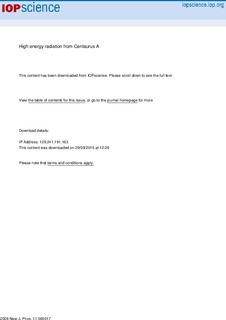| dc.contributor.author | Kachelriess, Michael | |
| dc.contributor.author | Ostapchenko, Sergey | |
| dc.contributor.author | Tomas, R | |
| dc.date.accessioned | 2015-09-29T11:29:08Z | |
| dc.date.accessioned | 2015-10-15T13:26:12Z | |
| dc.date.available | 2015-09-29T11:29:08Z | |
| dc.date.available | 2015-10-15T13:26:12Z | |
| dc.date.issued | 2009 | |
| dc.identifier.citation | New Journal of Physics 2009, 11 | nb_NO |
| dc.identifier.issn | 1367-2630 | |
| dc.identifier.uri | http://hdl.handle.net/11250/2356241 | |
| dc.description.abstract | We calculate, for the nearest active galactic nucleus (AGN), Centaurus A (Cen A), the flux of high-energy cosmic rays (CR) and of accompanying secondary photons and neutrinos expected from hadronic interactions in the source. We use as the two basic models for the generation of ultrahigh-energy cosmic rays (UHECR) shock acceleration in the radio jet and acceleration in the regular electromagnetic field close to the core of the AGN. While scattering on photons dominates in scenarios with acceleration close to the core, scattering on gas becomes more important if acceleration takes place along the jet. Normalizing the UHECR flux from Cen A to the observations of the Auger experiment, the neutrino flux may be marginally observable in a 1 km3 neutrino telescope, if a steep UHECR flux dN/dE∝E-α with α=2.7 extends down to 1017 eV. The associated photon flux is close to or exceeds the observational data of atmospheric Cherenkov and γ-ray telescopes for α2. In particular, we find that already the present data favour either a softer UHECR injection spectrum than α=2.7 for Cen A or a lower UHECR flux than expected from the normalization to the Auger observations. | nb_NO |
| dc.language.iso | eng | nb_NO |
| dc.publisher | IOP Publishing | nb_NO |
| dc.title | High energy radiation from Centaurus A | nb_NO |
| dc.type | Journal article | nb_NO |
| dc.type | Peer reviewed | en_GB |
| dc.date.updated | 2015-09-29T11:29:08Z | |
| dc.source.volume | 11 | nb_NO |
| dc.source.journal | New Journal of Physics | nb_NO |
| dc.identifier.doi | 10.1088/1367-2630/11/6/065017 | |
| dc.identifier.cristin | 352380 | |
| dc.description.localcode | © IOP Publishing Ltd and Deutsche Physikalische Gesellschaft. Creative Commons Attribution License. | nb_NO |
